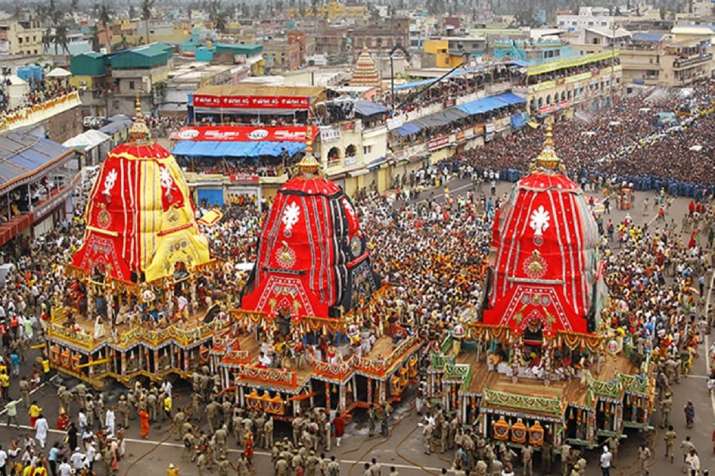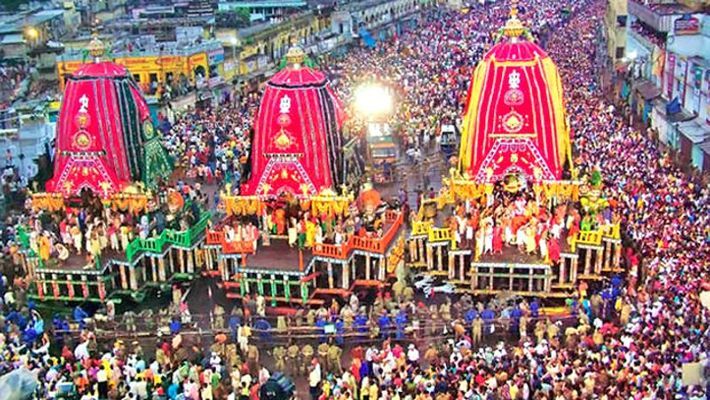ॐ श्री गुरुभ्यो नमः ॐ श्री शिवानन्दाय नमः ॐ श्री चिदानन्दाय नमःॐ श्री दुर्गायै नमः
Source of all Images in this Blog-post : Google Images : ‘Google Image Search’ will reveal the multiple sources of every single image shared here. For more details, kindly see ‘Disclaimer‘

Ratha Yatra or Car Festival or Chariot Festival is a Hindu festival associated with Lord Jagannath held at Puri in the state of Odisha in India. It is the oldest Ratha Yatra taking place in India and the world.
The descriptions of this Ratha Yatra can be found in ancient Brahma Purana, Padma Purana, and Skanda Purana and Kapila Samhita.
This annual festival is celebrated on the day of Ashadha Shukla Paksha Dwitiya – the second day in the bright fortnight of Hindu month of Ashadha.
The festival commemorates Jagannath’s annual visit to Gundicha Temple via Mausi Maa Temple (Maternal Aunt’s Home) near Saradha Bali in Puri.

Description
RATHA YATRA is the Festival of Chariot. The Chariot festival of Shri Jagannath temple is celebrated every year at Puri, the temple town in Odisha, on the second (Dwitiya) day of Shukla Paksha (Waxing Cycle of Moon) of Āshādha Māsa (3rd month of Odia calendar).
The presiding deities of the Jagannath Temple, Puri’s main temple, Lord Jagannath, Lord Balabhadra and Goddess Subhadra, with the celestial wheel- Sudarshana Chakra are removed from the temple in a ceremonial procession to their chariots.
The huge colourfully decorated chariots are drawn by multitude of devotees on the Bada Danda, the grand avenue to the Gundicha Temple (Gundicha was King Indradyumna’s Queen), two miles away to the North.
On the way the chariot of Lord Jagannatha, Nandighosa waits near the crematorium of Bhakta Salabega, a Muslim devotee to pay tribute to the Lord.
On their way back from the Gundicha Temple, the three deities stop for a while near the Mausi Maa Temple (Aunt’s abode) and have an offering of the Poda Pitha, which is a special type of pancake supposed to be the Lord’s favourite.
After a stay for seven days there, the deities return to their own abode.
The Chariots
The three chariots of Jagannath, Balabhadra and Subhdra are newly constructed every year with wood of specified trees like Phassi, Dhausa etc.
They are customarily brought from the ex-princely state of Dasapalla by a specialist team of carpenters who have hereditary rights and privileges for the sacred work.
The logs are traditionally set afloat as rafts in the river Mahanadi. These are collected near Puri and then transported by road.
The three chariots, decorated as per the unique instructions prescribed in the scriptures and followed for centuries, stand on the Bada Danda, the Grand Avenue.
The chariots are lined across the wide avenue in front of the temple close to its eastern entrance, which is also known as the Sinhadwara or the Lion’s Gate.
Around each of the chariots are nine Parsva Devatas – painted wooden images representing different deities – on the chariots’ sides. Each chariot has a charioteer (Sarathi) and four horses.
Chandana Yatra
The construction of the chariots starts on Akshaya Tritiya, the third day of the bright fortnight of Vaisakha, with ritual fire worship. This takes place in front of the palace of the King of Puri and opposite the main office of the Puri temple.
On this day, the new agricultural season starts and farmers start ploughing their fields.
This day also marks the beginning of the summer festival of the deities, also known as the sandalwood festival or Chandan Yatra, which lasts for three weeks.
In this festival, the representative images of the presiding deities are taken out in colorful processions and given a ceremonial boat ride in the Narendra Pokhari tank every day.
In the Jagannatha cult, Madanmohana and Rama-Krishna, representing Jagannatha & Balarama, partake in the festival with the images of the presiding deities of five main Shiva temples of Puri. These are surprisingly known as Pancha Pandava, the five brothers of the great Hindu epic Mahabharata.
Later the deities have a ritual bath in a small temple in the middle of the tank, in stone tubs filled with water, sandalwood paste, scents, and flowers.
This sandalwood festival culminates in the Snana Yatra – the Bathing Festival – on the full moon day of the month of Jyestha. On this day, the presiding deities descend from their seats on an elevated platform in the Sanctum Sanctorum.
The deities are bathed in 108 pots of water brought from the Suna Kua – the golden well – and assume the form of elephant on the special bathing platform, close to the Eastern boundary wall of the temple.
From this day the deities remain in symbolic and ritual convalescence for about two weeks. They are barred from the view of the ordinary devotees.
Only three special Pattachitras – traditional ethnic Oriya paintings of natural colors on cloth stiffened with starch known as Anasara Pattis – are hung on a bamboo screen hiding the deities from public view, and can be seen by the public.
During this period, the deities are given only roots, leaves, berries and fruits to cure them of their ailment.
Suna Besha
After the chariots of the deities return to the main temple from the Gundicha temple, the deities are attired in ornaments of gold, and worshipped on the chariots. This celebration is known as Suna Besha.
Tradition says that this event was first started by King Kapilendra Deb in 1460, when after returning victorious from a war he donated gold to Lord Jagannath. The deities are adorned with gold jewelry weighing nearly 208 kg.
International Ratha Yatra
The Ratha Yatra festival has become a common sight in most major cities of the world since 1968 through the ISKCON Hare Krishna movement.
By the grace of Mahaprabhu Shri Jagannath and Chaitanya, A. C. Bhaktivedanta Swami Prabhupada had successfully transplanted the festival which is now celebrated every year all over the world in over 108 cities.
Some of these cities are Moscow, New York, Houston, Atlanta, London, Rome, Zürich, Kolkata, Mumbai, Karachi, Berlin, Heidelberg, Cologne, Florence, Wroclaw, Sydney and Perth
And also Kampala, Nairobi, Mombasa, Kisumu, Mexico City, Dublin, Belfast, Manchester, Birmingham, Alchevsk, Buenos Aires, Madrid, Stockholm, Bath, Budapest and Auckland.
And also Melbourne, Montreal, Paris, Copenhagen, Amsterdam, Los Angeles, Toronto, Vancouver, Santiago, Tallinn, Lima, Antwerp, Sofia, Kuala Lumpur, Oslo, Zhongshan, Myitkyina, Bangkok among many other cities.
The Ratha Yatra in Dhamrai, Bangladesh, is one of the most important festivals in Bangladesh.
